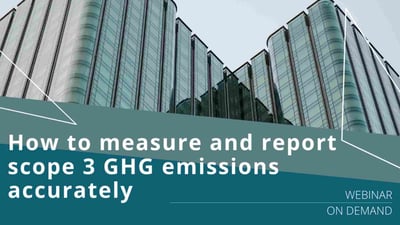GHG and carbon emissions and their role in limiting warming to 1.5°C
 With the latest IPCC report, the much anticipated COP26 conference and almost constant news reports on the subject, climate change and the reduction of carbon now seem to be at the centre of most discussions. As our attention is turned towards the ways businesses can act now to limit warming to 1.5°C, some terms used can lead to confusion.
With the latest IPCC report, the much anticipated COP26 conference and almost constant news reports on the subject, climate change and the reduction of carbon now seem to be at the centre of most discussions. As our attention is turned towards the ways businesses can act now to limit warming to 1.5°C, some terms used can lead to confusion.
This blog discusses the difference between terms such as ‘GHG’ and ‘carbon’ emissions and their connection to climate change. We will also touch on the impact that COVID-19 has had on emissions and how the right sustainability reporting software can help organisations track and report on their climate targets.
Carbon emissions
The terms ‘GHG emissions’ and ‘carbon emissions’ are used interchangeably in everyday conversation. Carbon emissions have become the shorthand for carbon dioxide (CO2) emissions and/or carbon dioxide equivalent.
CO2 is an important heat-trapping (greenhouse) gas, which is released through human activities such as deforestation and burning fossil fuels, as well as natural processes such as respiration and volcanic eruptions. It consists of one part carbon and two parts oxygen and is one of the most important gases on the earth because plants use it to produce carbohydrates in a process called photosynthesis.
GHG emissions
Greenhouse gases (GHGs) are gases in the atmosphere that absorb and emit radiant energy, causing the ‘greenhouse effect’. They let sunlight pass through the atmosphere, but they prevent the heat that the sunlight brings from leaving the atmosphere. The main greenhouse gases covered by the Kyoto Protocol are:
- Water vapour
- Carbon dioxide
- Methane
- Nitrous oxide
- Fluorinated gases
Human activities (including the consumption of energy and burning fuel in buildings and transportation) have increased the amount of these gases in the atmosphere, which in turn has increased the rate of natural global warming and caused adverse climate change.
The main greenhouse gases emitted by companies are carbon dioxide (CO₂), methane (CH₄) and nitrous oxide (N₂O). These gases are usually expressed as a “carbon footprint” in tonnes of carbon dioxide equivalent (tCO₂e). Given that a single activity can cause multiple greenhouse gases to be emitted, each in different quantities, a carbon footprint if written out in full could get confusing. So carbon dioxide equivalent (tCO2e) is a standard unit for counting greenhouse gas emissions regardless of whether they’re from carbon dioxide or another gas, such as methane.
What’s included in a GHG footprint?
The GHG Protocol classifies a company's GHG emissions into three categories or "scopes", to unify reporting and accounting of emissions worldwide.
Scope 1 emissions: Covers all direct emissions from owned or controlled sources, such as energy consumption, fuels, vehicles, etc.
Scope 2 emissions: Covers indirect emissions from the generation of purchased electricity, steam, heating or cooling energy consumed by the company.
Scope 3 emissions: Covers all indirect emissions that occur in the value chain of the reporting company. Scope 3 emissions are split between 15 categories, including both upstream and downstream emissions. As scope 3 emissions are the result of activities from assets not owned by the company, one company’s scope 3 emissions may originate from another company’s own scope 1, Scope 2 or even scope 3 emissions.
Relation to Climate change
Variations in gases such as carbon dioxide (CO₂) occur naturally in the atmosphere. However, current levels have reached a new limit.
Based on IPCC’s latest climate report, human activities are estimated to have caused approximately 1.0°C of global warming above pre-industrial levels. Global warming is likely to reach or exceed 1.5°C between 2030 and 2052 if it continues to increase at the current rate. This means that the emissions trajectory required to avoid crossing the 1.5°C threshold mandates a significant reduction by 2030.
The NDC Synthesis report indicates that while there is a clear trend that greenhouse gas emissions are being reduced over time, when taking all 191 Parties of the Paris Agreement into account, global GHG emissions in 2030 are expected to be 16% higher compared to 2010.
COVID-19 impact
As social and economic activity came to a standstill throughout the world in 2020 due to the COVID-19 pandemic, GHG emissions plummeted.
According to IEA, as primary energy demand dropped nearly 4% in 2020, global energy-related CO₂ emissions fell by 5.8%, the largest annual percentage decline since World War II. As the first wave of the pandemic was brought under control and economic activity increased towards the middle of the year, emissions increased. They continued to rebound through the rest of the year. In December 2020, global emissions were 2% higher than they were in the same month a year earlier.
You can now watch on-demand our webinar on: 'Reporting the impacts of COVID-19 in your environmental reports'.
COVID-19 has had a notable impact on global CO₂ emissions. Or at least that's how it appeared to be. Looking at the data in more detail, however, we quickly realise that in reality, it was just a drop in the ocean. There's a lot more work that needs to be done to reach our goals.
The IEA Sustainable Recovery report, published in June 2020, outlined a pathway to avoid a rebound in emissions, with the Sustainable Recovery Plan providing clear recommendations on how to create jobs, boost economic growth and significantly reduce emissions simultaneously.
How companies can help to limit global warming
Companies can lead the way to a zero-carbon economy, boost innovation and drive sustainable growth by setting ambitious, science-based emissions reduction targets. A survey of SBTi companies confirms that science-based targets are not only good for the planet but are also good for business.
By setting a net-zero target in line with a 1.5°C future, companies can make a critical contribution to limiting the worst impacts of climate change. ‘Business Ambition for 1.5°C’ is an urgent call to action from a global coalition of UN agencies, business and industry leaders, in partnership with the Race to Zero.
Greenstone & GHG emissions - how Greenstone can help with targets
Through its sustainability reporting software and supporting services, Greenstone enables its clients to accurately measure and report GHG emissions across their organisation, supply chain and investments.
Greenstone’s suite of ESG, supply chain and sustainability reporting software solutions provide integrated GHG emissions calculations using 1m+ emissions factors from international standards including GHG Protocol, Defra, US EPA and IEA. You can set short or long term, absolute or normalised emissions and consumption targets at any level of the organisation. Emission targets can be set for general emissions or for a specific data source.
Greenstone’s sustainability reporting software includes an enhanced Targets functionality in the Environment module. Science-based targets, net-zero targets and consumption and emissions targets can be tracked and monitored over time using Greenstone’s targets dashboards.
"We needed a software platform that would allow us to expand participation and improve engagement in environmental metrics reporting across our company and Tier 1 supply chain. Greenstone meets that need today and can grow with us into the future.”
Elysa Hammond, Director of Environmental Stewardship, Clif Bar
Clif Bar implemented the Environment module of Greenstone’s Enterprise software to collect, calculate and report on consumption and emissions data from across 12 different sites. Learn more about the challenges and discover the results - Download the full project case study.
To find out more about how Greenstone’s award-winning sustainability reporting software can help you achieve your sustainability goals, please talk to us.
Continue reading: Key aspects to consider in sustainability reporting
On-Demand Webinar | How to measure and report scope 3 GHG emissions accurately










